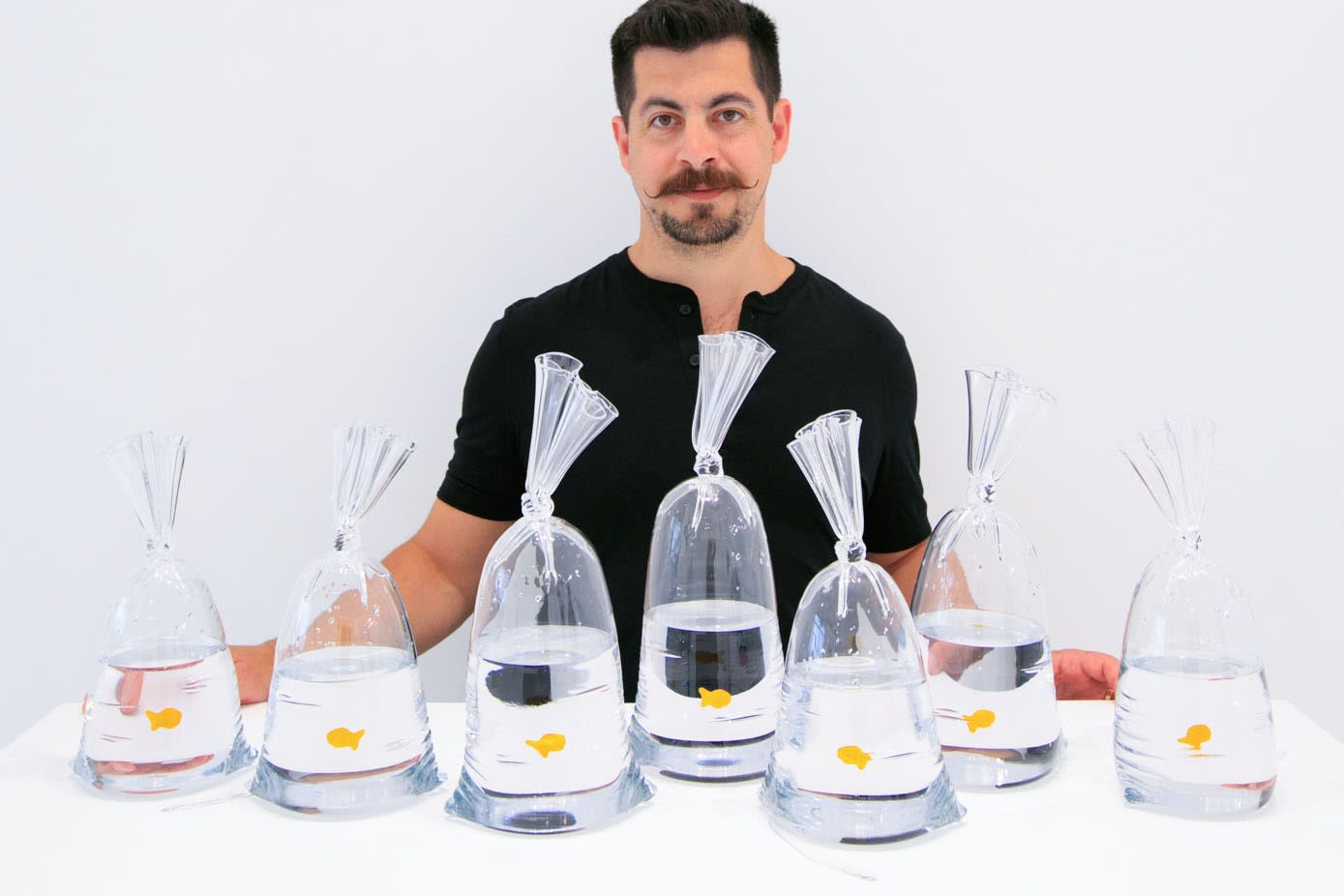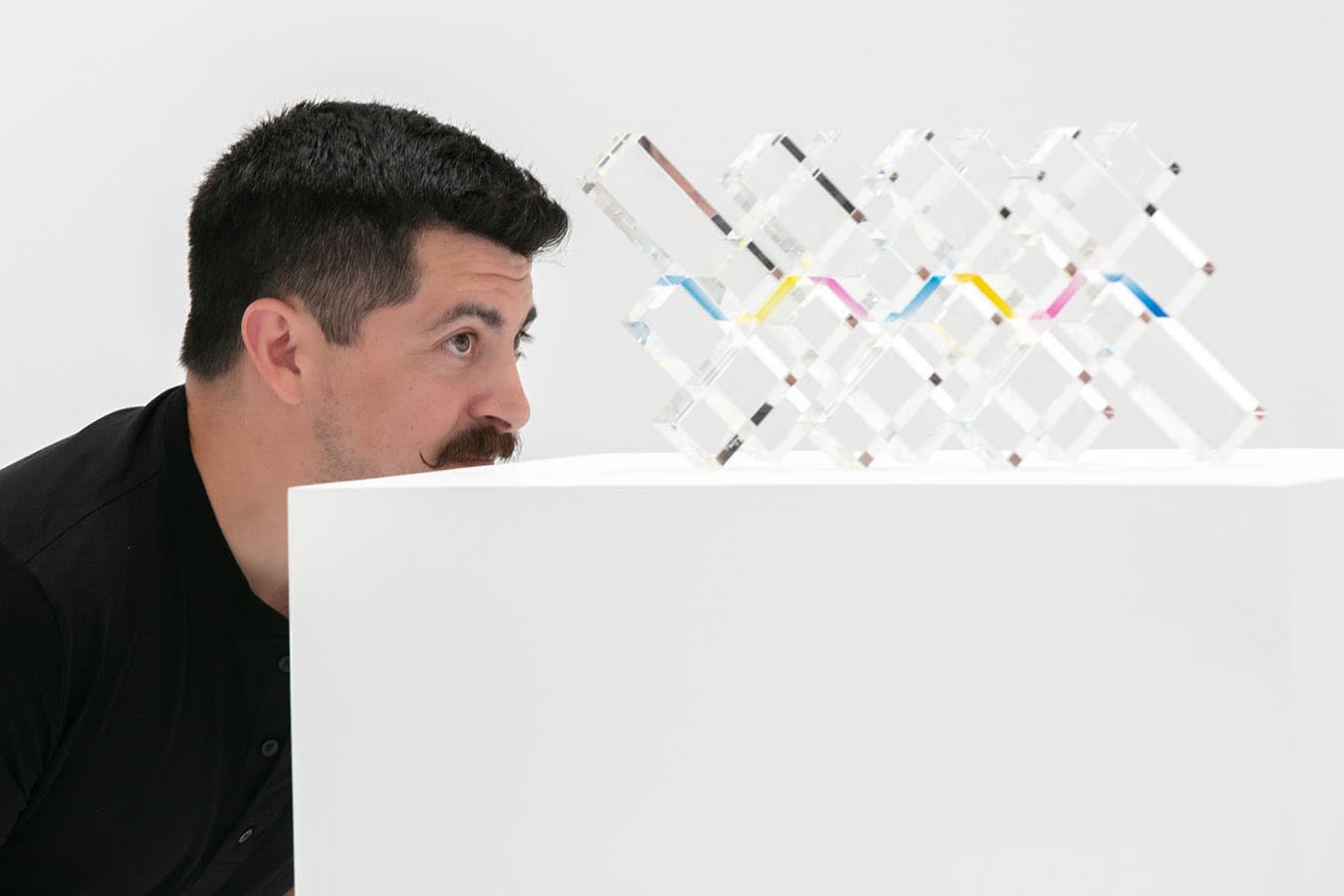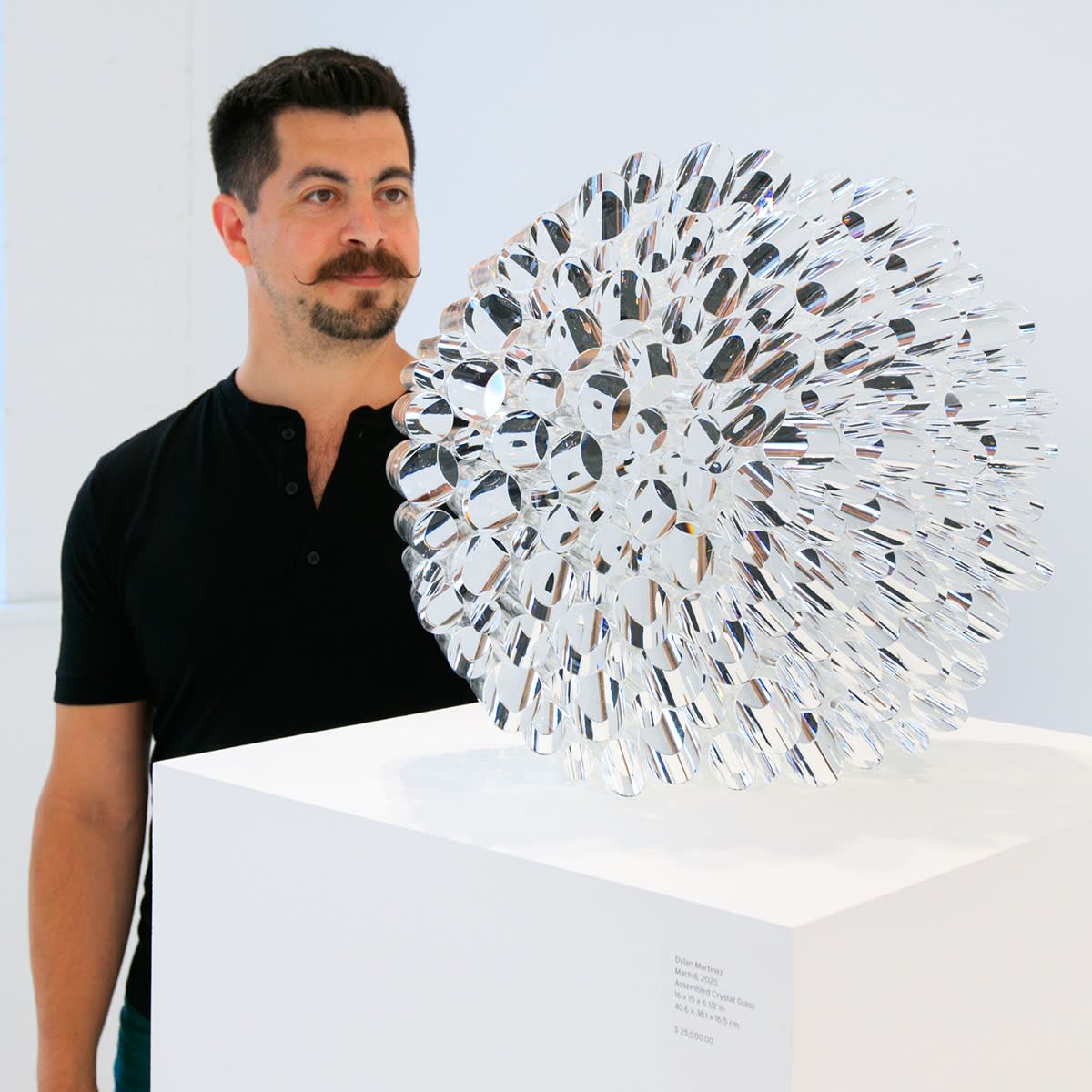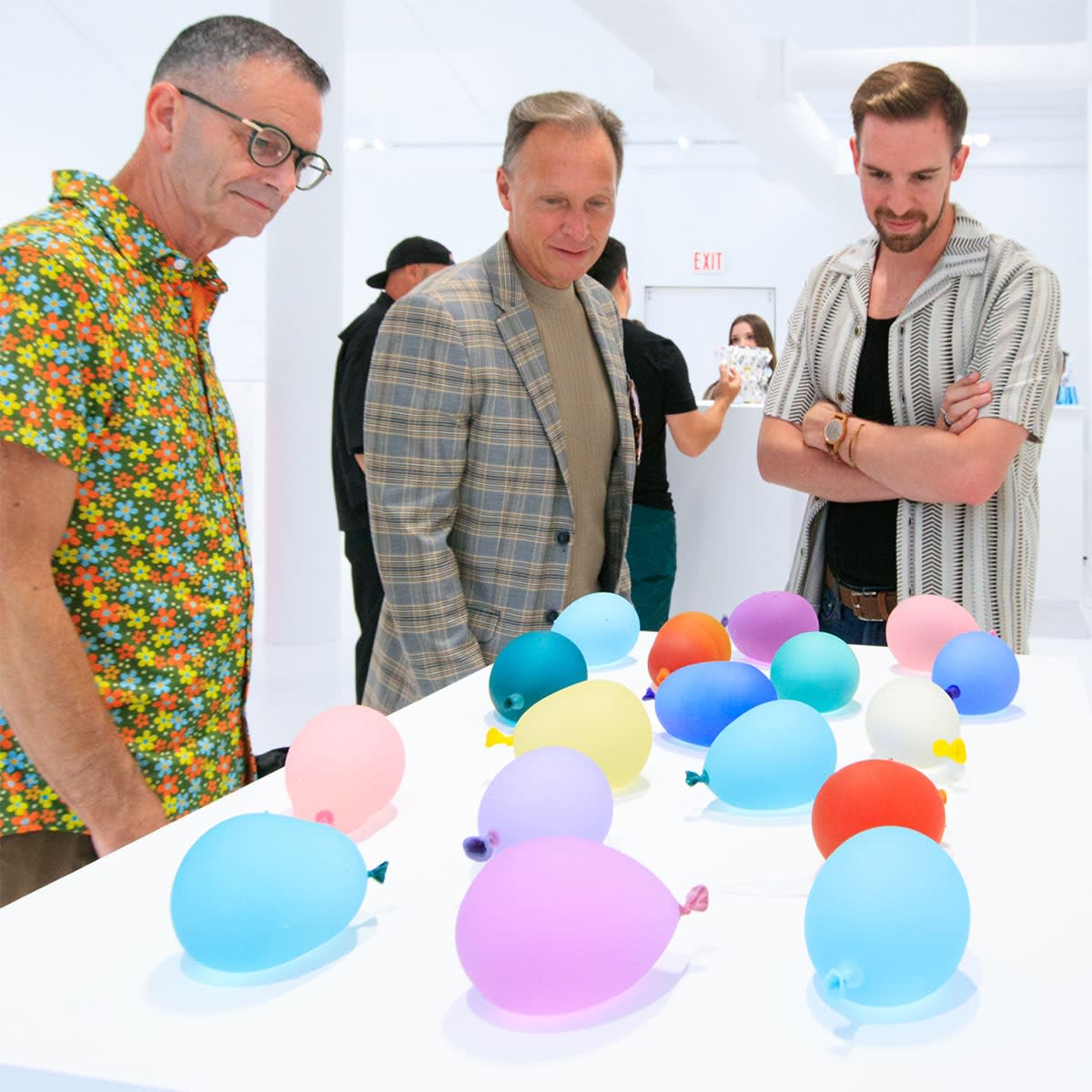“Glass is the lie that reveals the truth.” - Dylan Martinez
Dylan Martinez creates hyperreal glass sculptures that blur the boundary between the seen and the believed. Whether mimicking water-filled plastic bags or evoking digital ghosts in solid form, his work challenges our perception of material, memory, and reality. What looks disposable becomes precious. What seems fluid is rigid. Through illusion, Martinez invites the viewer into a deeper awareness of how—and why—we see.

Dylan Martinez with "Goldfish Cracker Water Bags" at Square One Gallery
For his debut exhibition with Square One Gallery,“Glass Reimagined” presents a series of hyperrealistic sculptures and installations that challenge our assumptions about material, perception, and play. From water bags inhabited by bubble-formed fish to drinkware that holds only the illusion of liquid, the exhibition invites viewers to question what they see—and what they believe they see.
We sat down with Dylan to discuss his inspirations, mastering glass blowing, and the art of illusion.

Dylan Martinez with "CMY" at Square One Gallery
How did you get into glassblowing and sculpting? What was the most difficult technique to master?
I discovered glassblowing in my junior year of college when I took it as an elective, and I was instantly hooked. The combination of discipline, precision, and problem-solving keeps me engaged, always pushing for new challenges.
There are many techniques considered difficult, but the greatest challenge isn’t mastering an established technique—it’s developing entirely new methodologies. Creating innovative work requires not just skill but ingenuity, patience, and a deep understanding of the material’s behavior. It’s one thing to refine an existing process; it’s another to carve your own path.
Interestingly, I’ve found that the most technically impressive techniques often resonate most with other glass artists rather than a broader audience. There’s a temptation to focus on craft for craft’s sake, but I strive to create work that transcends technical mastery and connects with viewers on a deeper, more visceral level.
What draws you to create pieces that mirror real objects versus those that are more abstract?
For me, the idea dictates the process. My best concepts arrive as flashes of inspiration—almost like being struck by a muse. That doesn’t mean I just wait for ideas to appear; I cultivate the right conditions in my personal and professional life to invite creativity in.
Glass is a magical, transformative material, and the worst thing I could do as an artist is limit myself to a singular style. I’m too curious for that. I embrace both realism and abstraction because working within extremes allows for unexpected discoveries. Duality is a recurring theme in my practice—fluid versus rigid, real versus surreal. The dialogue between opposites keeps my work evolving.

Dylan Martinez with "Mach 8" at Square One Gallery
What has been your favorite sculpture style you've worked on so far? Do you think that feeling has been reciprocated by admirers of your work?
I don’t have a single favorite. I move between different styles and approaches to keep things fresh. I’m drawn to work that challenges my current skill set—designing and executing pieces that are just beyond my abilities forces me to grow.
At the same time, I appreciate the elegance of simplicity. Simplicity isn’t about making something easy; it’s about refining an idea until only the essential remains. Every detail matters because anything unnecessary becomes a distraction.
I believe my audience connects with this approach because my work is consistently exhibited and collected globally. That tells me that people aren’t just appreciating the craftsmanship but also engaging with the ideas behind the work.
What drew you to the trompe l'oeil style? What do you find interesting about it?
Trompe l’oeil is fascinating because it operates on both technical and psychological levels. At its core, it’s about mastery—convincing the viewer that glass is something it’s not. But the real intrigue lies in how our minds process the illusion.
What interests me most is the way our brains instinctively fill in gaps. My work isn’t an exact replica of the real object, but it’s close enough that the mind smooths over any discrepancies. I play with that balance—pushing the realism just far enough that the illusion feels more “real” than the actual object itself. The challenge is not just in the execution but in embedding subtle cues that invite the viewer to question their assumptions.

What are some similarities and differences in your intentions when working with fluid, realistic pieces versus angular, abstract ones?
Both styles exploit the physical properties of glass but in different ways. My fluid, hyperrealistic pieces emphasize glass’s natural movement, capturing its organic, liquid qualities. In contrast, my more angular, abstract work plays with the material’s optical and structural properties—how it bends and refracts light, how it distorts perception.
At their core, both approaches share the same goal: to celebrate the unique nature of glass and to spark a sense of wonder in the viewer.
What challenges have you faced working with glass? Do you ever have ideas that are difficult to execute?
Glass is an incredibly demanding material. It can do amazing things, but it’s also unforgiving. I constantly push its limits, exploring the edges of what’s possible. Some ideas require solutions that are just beyond my current reach, while others feel like they’re just one epiphany away.
The unpredictability of glass is part of the challenge. Its properties shift at different temperatures, and many of those variables are invisible. A piece can survive a hundred delicate steps only to shatter from a tiny miscalculation. Walking that razor’s edge of fragility is both exhilarating and humbling.
 Guests at Square One Gallery with Dylan Martinez's Water Balloon sculptures
Guests at Square One Gallery with Dylan Martinez's Water Balloon sculptures
What role does nostalgia and personal memory play in the objects you recreate and
do you see yourself exploring new objects and perceptual illusions in the future?
Absolutely. That’s the whole point.
By recreating fragile, impermanent objects in glass, I’m preserving something that was never meant to last. The tension between the material’s permanence and the subject’s ephemerality mirrors the way we experience nostalgia itself: we hold onto memories, but they shift and distort over time. My work invites viewers to engage with that feeling—to reflect on their own past experiences, to recognize the beauty in impermanence, and to consider how memory shapes the way we see the present.
Learn more about Dylan Martinez, his debut solo exhibition with Square One Gallery, and his avaiable works through the link here.

